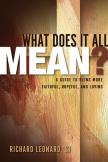A God worthy of belief
Shortly before his death in 2012, Cardinal Carlo Maria Martini—a Jesuit who was once considered a papabile (potential pope)—publically declared the Catholic Church “200 years out of date.” Whether Pope Francis would agree with that assessment or not, since his election the first Jesuit pope has made strides in giving the church a friendlier, more welcoming face—sometimes over steep opposition from within the hierarchy. Now Richard Leonard, a Jesuit from Australia, has written a book that aims to present basic Catholic teaching in a credibly humane and deeply orthodox way—to justify not only the church and religion itself but the true God of Christian faith. He is convinced that many have distorted images of God, not only aggressively atheistic God-bashers but some devout Christians whose God seems more like Zeus than the loving Father revealed by Jesus. Leonard wishes not just to set the record straight but to present an image of a God truly worthy of belief, one consistent both with the New Testament and contemporary knowledge and experience. “I have a deep and searching faith in and about God,” he writes, and he wants to share that faith (and that search) with his readers.
As its title promises, the book grapples with the biggest of issues: the meaning of life, the problem of evil and the value of praying to a God who seems only rarely to intervene in human affairs. Leonard goes about this ambitious task in a way that is primarily pastoral rather than scholarly, drawing on his own experience as a priest and events in the life of his family. In one of the most moving and memorable parts of the book, he recounts the aftermath of an accident that left his young sister, newly returned from working with Mother Teresa in Calcutta, a quadriplegic, unable to feed or bathe herself or even turn over in bed. Here Leonard wrestles with the mystery of suffering in a very concrete and personal way. Rejecting some well-meant attempts at religious consolation (“Tracy is storing up merit in heaven”; “Everything that happens is part of God’s plan”), he finds God’s will “more in the big picture than in the details” and opts for a vision of God present in all human suffering, not only that of Jesus. This section, based in part on the author’s earlier book Where the Hell Is God? would provide excellent material for reflection in parish discussion groups and classes at the secondary or college level.
Leonard goes about this ambitious task in a way that is primarily pastoral rather than scholarly, drawing on his own experience as a priest and events in the life of his family.
Written with humor and brio as well as serious meditation on great metaphysical issues, What Does It All Mean? ranges widely over topics like biblical authority, the historical Jesus, the history of the church, the priestly sexual abuse scandal, women’s leadership roles in the church, Mary and more. On each of these the author has something insightful to say. At times he seems almost manic in his desire to cover everything. (In a revealing comment, he refers to his “very active lifestyle,” involving many plane flights from Down Under to places like Los Angeles and New York. It led one Jesuit superior to challenge him with the question, “Why are you on the move all the time?” He answered, “Because I can.”)
Regardless, the benefits to the reader are many. A number of chapters conclude with brief biographies of holy people past and present: St. Thomas More, Blessed Óscar Romero, Dorothy Day, St. Teresa of Calcutta and—a new one to me—St. Mary Mackillop. This last, Australia’s only canonized saint, founded in the 19th century a religious community dedicated to educating poor children. She ran afoul of several Australian bishops and was even excommunicated by one, only to be vindicated by Rome through the efforts of a Jew, a Presbyterian and two Jesuits. Leonard says she is probably the only woman since Joan of Arc to have gone from excommunication to canonization. He observes that many saints have had “complex personal histories” before their conversion to holiness, often involving a lot of extramarital sex—like St. Augustine, who said, “There is no saint without a past, no sinner without a future.”
The funniest episode in the book is Leonard’s description of how as a newly ordained priest in Sydney, his celebration of the Christmas midnight Mass at a parish was invaded by five obviously gay men who were performers in a local cabaret show called “Les Girls.” (One told him that he “wore his frock divinely.”) After Mass, at the social, he welcomed them to the parish and in return received an invitation to their 3 a.m. show—which he attended, in the company of three young visiting Jesuits. Subsequently, Leonard became pastorally involved with the performers, eventually burying three of them and baptizing and performing the wedding of a fourth, whose wife he received into the church. His pastoral style, like that of Francis’ papacy, is nothing if not welcoming and inclusive.
One of the best sections of his book is an illuminating commentary on the Ignatian “discernment of spirits” in the Spiritual Exercises. I recommend it, as I do his advice to parents who say they “only want their children to be happy.” Tell them instead, he says, “to be the most faithful, hoping, and loving people they can be.” It is a recipe that also makes for happiness, as it evidently has done in the life of the author.
This article also appeared in print, under the headline “A God worthy of belief,” in the August 21, 2017, issue.










